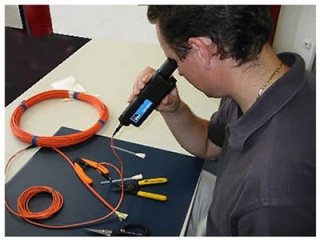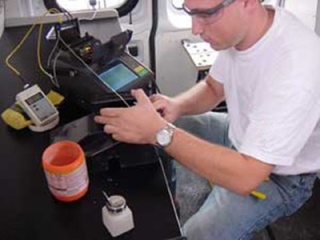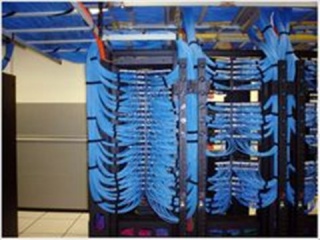Be Careful When Working With Fiber Optic Cable
srijeda , 20.07.2016.It’s known that safety issues or hazards are commonplace in both copper and fiber cabling installation, faced by installers. And when it comes to this topic, many people think that copper cabling installation need more attention and caution, since they carry electricity. In comparison, optical fibers are safer because of the light they carry. But actually, this concept is misplaced. As to fiber optic cables, whose ends are capped with the same or different connectors (e.g. ST ST fiber cable and LC to SC cable), they carry data in the form of light which can bring harms to the eyes.
Many people are unaware of the problems that fiber poses. Some installers don’t think much of fiber optic issues, and they don’t take proper safety precautions to avoid the many hazards that can be caused by fiber optics. Working with fiber optic cables needs much caution, and installers need to do the two points for safety: fiber fragment disposal and eye protection.
Fiber Fragment Disposal
When an installer is trimming, stripping, or cutting fibers, tiny fragments may fall where it will--on the top of the table where the job is being done, at the bottom of the raised floor, or maybe into a cup of coffee that is close by. The scraps may even be brushed into a nearby garbage can. Then what happens if someone rests his or her hand on top of that fiber scrap? The glass is transparent and the scrap is probably small, so unless the person is the one who did the terminating, he or she may not know the hazard is there. Because of this, workers should not eat or drink in a fiber optic work area since a fiber scrap could fall onto their food or in their drink.
It’s important to keep in mind that tiny fiber fragments can penetrate the skin and become embedded, causing a serious irritation. Ingested fibers can cause internal damage since they are light enough to float in air.
To avoid such potential danger, these safety kits can be used:safety glasses (for keeping eyes free of scraps), a black polishing/work mat (the black surface makes it easier to locate fiber scraps), Teflon-coated tweezers to remove splinters (regular tweezer ends break fiber scraps), and a bifurcated swipe (for cleaning fiber ends and sterilizing the tweezers for splinter removal). One of the most popular components of the kit is the fiber-scrap trash can, which provides a single place for disposing of bits of fiber. Once full, the small trash can may be incinerated.
Eye Protection
After finishing cable installation, many installers unfamiliar with fiber-optic technology may look at the fiber’s end to verify that light is being transmitted, which causes the loss of visual acuity or blind spots because the beam is focused on the retina. What’s even worse is that the light used in fiber- optic communications systems is in the infrared range and is not visible to the human eye.
So when working with fiber optics, all workers performing any splicing or termination activities should always wear safety glasses with side shields. Any other people or site managers entering the work area should wear safety glasses with side shields also. Unless an installer is absolutely sure there is not a light source at the other end, they should never look directly into the end of the cable. A power meter can be used to make certain the fiber is dark.
Other Safety Considerations
Chemicals: Fiber optic splicing and termination use various chemical cleaners and adhesives as part of the processes. Normal handling procedures for these substances should be observed. Even simple isopropyl alcohol, used as a cleaner, is flammable and should be handled carefully. Manufacturers will supply "material safety data sheets" (MSDS) on request or they may be found on the Internet.
Splicing hazards: Fusion splicers use an electric arc to make splices, so care must be taken to insure no flammable gasses are present in the space where fusion splicing is done.
No Smoking: Smoking should also not be allowed around fiber optic work. The ashes from smoking contribute to the dirt problems with fibers, in addition to the possible presence of combustible substances (and, of course, the health risks.)
Safety Tips
While working with fiber optics, the worker needs a well-ventilated and well-lit work area. Workers must avoid smoking while working with fiber optics.
Also, all food and beverages should be kept out of the work area. Workers can wear disposable aprons to keep fiber particles off their clothing. Before leaving the work area, an employee should always check their clothing for pieces of stray fiber, and if any are found, they can remove it with double-sided tape.
A worker should wash their hands thoroughly before touching their eyes, and contact lens wearers should wash their hands before touching their lenses. Workers should also read all instructional material before handling chemicals.
A disposable container that can be tightly closed must be used for fiber scraps. When finished with a fiber optic job, all cut fiber pieces should be disposed of properly along with any used chemicals and containers. The work area should be thoroughly cleaned when job is completed.
Conclusion
Understanding the potential dangers and knowing the simple fiber optic safety tips can keep the working environment clean and safe for workers, so as to avoid hazards. As an outstanding fiber patch cord manufacturer, Fiberstore supplies various kinds of fiber optic cables for your cabling installation, test- and quality-assured. You can have a try here.
Oznake: fiber optic cables, ST ST fiber cable, fiber cabling installation, fiber fragments, eye protection, fiber patch cord manufacturer
komentiraj (0) * ispiši * #
Fiber Optics: Do You Know Its History & Advantages?
srijeda , 22.06.2016.As we all know that the medium is considered as the simplest form of fiber optics, which is used to carry information from one point to another in the form of light. It's comprised of a transmitter used to generate the light signal, a fiber optic cable that functions as a conduit for pulses of light to travel over distances,, and a receiver to accept the light signal transmitted. In practical use, fiber systems are often deployed as the alternative solutions to traditional copper-based communications systems, since fiber optic cables outperform copper cables in less signal loss and immunity to electromagnetic interference (EMI). Of course, the advantages of fiber optics are denifinely not confined to these two points. Read this article and the following detail the several strong points of fiber optics used in communication systems, as well as its history.
Fiber Optics: History
In 1880, the photophone was invented, a great inventory used to speak into a microphone which would then cause a mirror to vibrate. The sun's light would strike the mirror, and the vibration of the mirror would transmit light across an open distance of about 656ft (200m). The receiver's mirror would receive the light and cause a selenium crystal to vibrate, causing the noise to come out on the other end. Although the photophone was successful in allowing conversation over an open space, it had a few drawbacks: it did not work at night, in the rain or if someone walked between the signal and receiver. Then this idea was given up.
In 1950s, the laser was invented. This device was a finely controlled beam of light that could transmit information over long distances. Unfortunately, the same drawbacks also plagued the laser. Although it could be used at night, it did not work during rain, fog or at any time when a building was erected between the sender and the receiver.
Scientists at Corning developed the first practical fiber optic cables in the 1970s, based on the idea of "total internal reflection". This is the principle that fiber cables are built upon, and it basically means that an optical fiber consists of a core of transparent glass, surrounded by outer layer, (called "cladding") of slightly less transparent glass which reflects the light back into the core.
What Makes Fiber Optics Special?
What is special about fiber optics? As mentioned above, fiber optic cables are made out of glass, and carry pulses of light energy. The idea of a flexible piece of glass sounds a bit counter-intuitive, but in some ways, fiber optic cables are stronger and more durable than copper cables.
Nowadays, fiber optic cables are used for many different telecommunication applications, like data centers, data warehouses, server farms, SANs, and LANs. But actually, in their practical use, there exists a common question. One may find himself faced single-mode fibers (SMFs) and multi-mode fibers (MMFs) which are terminated with different connectors, such as LC (LC fiber cable), SC (LC to SC cable), MTP/MPO (MTP cable). When such things occur, it’s important to keep in mind that SMFs and MMFs are not compatible with each other, and can't mix them together between two end points.
Fiber Optics: Advantages
Why is fiber optics used in telecommunications? There are several reasons that make fiber systems more popular than copper ones.
Large Bandwidth & Long Distance
Bandwidth refers to the amount of data that can be passed along a cable in a given time period. If we think of cables as pipes, then bandwidth is the amount of water that can flow through the pipe in a second. The bigger the pipe, the more water can flow. Consider a normal communication cable that may be used to carry a single phone call. It is built out of copper, and may have the bandwidth of a normal drinking straw. By comparison, a fiber cable of the same physical size would provide more bandwidth.
Since fiber optic signal is made of light, very little signal loss occurs during transmission, and data can move at higher speeds and greater distances. In most cases, copper cables are limited to a range of 100meters or less. In contrast, the relatively small diameter and light weight of fiber optic cables can allow a wide range of distance reaches from 550meters to dozens of kilometers, which makes fiber ideal for applications where signals have to travel over long distances.
Immunity & Reliability
Fiber optics provides extremely reliable data transmission. It’s completely immune to many environmental factors that affect copper cable. The core is made of glass, which is an insulator, so no electric current can flow through. It’s immune to electrometric interference and radio-frequency interference (EMI/RFI), crosstalk, impedance problems, and more. You can run fiber optic cable next to industrial equipment without worry. Fiber is also less susceptible to temperature fluctuations than copper and can be submerged in water.
Security
The data is safe with fiber cable which doesn’t radiate signals, letting information difficult to be tapped. More specifically, the dielectric nature of fiber optic cable makes it impossible to remotely detect the signal being transmitted within the cable. If the cable is tapped, it’s very easy to monitor because the cable leaks light, causing the entire system to fail. If an attempt is made to break the physical security of your fiber system, you’ll know it. Fiber networks also enable you to put all your electronics and hardware in one central location, instead of having wiring closets with equipment throughout the building. They are very attractive for use in governmental institutions, finance/banking and other environments with major security concerns.
Summary
It's obvious that fiber optics has a growing usage in both private and public networks. It's able to transmit signals over significantly distance at high speed and large amount, extremely suitable for voice and data links. As an outstanding fiber patch cord manufacturer, Fiberstore provides various kinds of fiber optic cables terminated with the same or hybrid connectors on the ends to cover countless applications, including the above mentioend LC fiber cable, LC to SC cable, MTP cables, and so on. They are all supplied at cost-effective prices. Really worth your try.
Oznake: fiber optic cables, LC to SC cable, LC fiber cable, SMFs, MMFs, fiber patch cord manufacturer
komentiraj (0) * ispiši * #
Proper Management of Fiber Patch Cord
srijeda , 01.06.2016.Past several years has witnessed a rapid deployment of fiber optic patch cables in optical communication networks. Compared with electrical cables, fiber patch cords (or called fiber optic jumper) are designed with enormous bandwidth capabilities, which make them preferred in digital and analog data transmission. These jumpers are fiber optic cables that are terminated at each end with connectors that plug into various pieces of equipment, available in single-mode and multi-mode patch cord versions (with OM3 patch cable widely used for short-reach transmission).
As fiber optic technology develops, the installation of fiber patch cords becomes increasingly easy nowadays. But to guarantee smooth networking performance, the proper patch cable management is essential. With proper management, it’s simple to go on cable operation and maintenance, saving time and cost. This article mainly discusses five factors that need to be considered during patch cord management.
Kinks, snags, pinches and poor contacts can dramatically reduce the performance of a fiber patch cord. The following factors are important in avoiding these problems.
Bend Radius
Since fiber optic cable made of glass has a fragile core, it requires great care and attention to avoid breaking this core during cable termination and operation. And in no case is fiber’s bend radius allowed. The minimum bend radius for patch cords varies with cord diameter. For 1.6mm and 3.0mm cords, the minimum un-loaded bend radius is 1.4 in (3.5cm), and for InstaPATCH Plus MPO patch cords, the minimum bend radius is ten times the cord diameter. If a fiber cable is bent excessively, the optical signal within the cable may refract and escape through the fiber cladding which will cause a loss of signal strength and is known as bend loss.
In addition, bending, especially during the installation and pulling of fiber patch cable might also cause micro cracks, and damage the fiber permanently. Generally, there are two basic types of bends in fiber, which are microbends and macrobends, with the latter larger than the former (as is shown below).
Patch Cord Path
This factor is closely related to the bend radius. The patch cable path should be clearly defined and easy to follow. Improper cable routing can lead to increased congestion in the termination panel, increasing the possibility of bend radius violations and possible failure in long-term. However, the well managed patch cable path ensures that bend radius requirements are maintained at all points, making accessing individual patch cable easier, quicker and safer. If the existing cord is the right length, it may be possible to re-use it. If this is the case, remove the cord completely and re-run it in through the cable pathways. This is the only sure way to ensure there are no tangles, kinks or strains in the cord.
Patch Cord Pulling & Stress
It’s not advised to use excessive force during the patching process, since too much force can stress cords and connectors, degrading their performance. If you need to use force in pulling a cord and there is something wrong, then stop and find the problem, and fix it before proceeding.
Patch Cord Accessibility
If the installed patch cable is easy to be accessed, the maintenance and operation would be quick without inducing a macrobend on an adjacent fiber. Accessibility is critical during network reconfiguration operations and directly impacts operation costs and network reliability.
Physical Protection
Patch cords that are routed between pieces of equipment can largely affect network reliability. Without proper protection, they would be easy to be damaged by technicians and equipment accidentally. Thus, physical protection of the installed patch cords is very important.
After discussing patch cord management, hers is another notice. Patching patch cord is critical in the first time, since its mistakes may cause disruption. Thus, after managing patch cord, taking time to make a final visual check on connections is a good investment. When patch panels are mounted in enclosures, ensure these are securely closed and, where necessary, locked, making sure that cord slack is not snagged or pinched by the doors.
Conclusion
Proper management of fiber patch cord can help to decrease operating costs and the time required to turn-up or restore service, making the operation reliable and flexible. As a professional fiber patch cord manufacturer, Fiberstore Cable Management provides ideal solutions for the distribution of cables and access to power, data and communication services on the wall and under the floor and for pole. Keep in mind those above-mentioned five factors, then the proper cable management is halt-succeeded.
Oznake: fiber optic patch cables, fiber optic jumper, OM3 patch cable, fiber patch cord manufacturer, cable management
komentiraj (0) * ispiši * #







